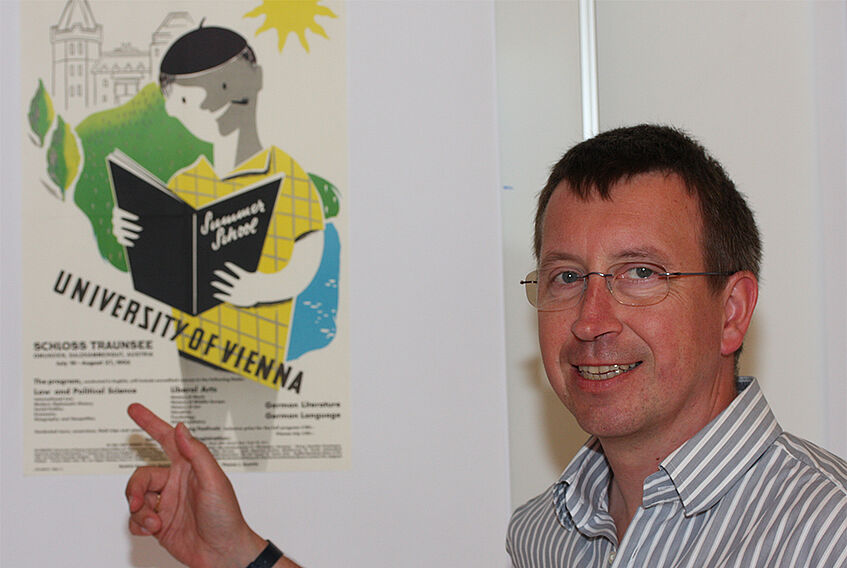History

Director Meissel with a poster for the summer school from the 50's
The suggestion for the founding of the Sommerhochschule was originally made by the Institute for International Education (IIE) in New York. This Institute, which was represented in Vienna by the America-Austria Society respectively the Austro-American Institute of Education (AAIE), had already held language courses for Americans in Vienna before World War II. The initial idea of the summer school was to provide an overview of Austria in past and present to American students.
The idea of the IIE to realize this program after World War II was suggested to the Österreichisch-Amerikanische Gesellschaft (ÖAG) by the American ambassador of that time. Finally the IIE and the ÖAG were able to win the University of Vienna to announce the summer school of 1949 as its academic program. The University of Vienna took charge of the academic organization, the administrative tasks were to be carried out by the IIE while the ÖAG was responsible for the financial aspect. The organization of the Sommerhochschule of the University of Vienna - as the program was then named - by three institutions proved however to be very problematic and as a result the first session of 1949 was seriously in danger for a time. Thanks to the extensive personal commitment of Dr. Schrems, the Director of the ÖAG at that time, Dr. Plöchl, the first Director of the Sommerhochschule (SHS), and Frau Schemminger, employee and later Director of the AAIE, the summer school 1949 could take place.
As it was not possible to hold the summer school in Vienna, which was occupied by the four Allied powers, the idea was born to organize the SHS like an American College on a campus. Thumersbach near Zell am See in the American zone was chosen for the first session of the SHS. This first session was officially opened with 69 participants on July 17, 1949 by Minister Dr. Felix Hurdes. The Federal Chancellor, Dipl.-Ing. Leopold Figl, visited the SHS this summer.
Within the next year the SHS changed the location and the second session was held in Schloss Traunstein near Gmunden. After the successful completion of the first two sessions, the administration of the University of Vienna established a committee, which was entrusted with the affairs of the SHS. Thereupon the SHS became a fixed institution of the University of Vienna, financially supported by the ÖAG.
Schloss Traunstein soon became too small for the growing number of participants and the SHS had to find another location. Upon suggestion of the University of Vienna, the Austrian Ministry of Education bought the Bürglgut in Strobl at Lake Wolfgang. The Bürglgut provided a campus for the SHS and at the same time accommodated the Bundesinstitut für Erwachsenenbildung (BIFEB).
In 1956 the first session of the summer school was held on the new campus at the Bürglgut. In the same year the ÖAG separated from the SHS and the University of Vienna assumed the entire financial responsibility. Since the SHS could not be financed solely from the tuition fees of the participants, it was sponsored by the Republic of Austria and private companies. In July 1957 the sponsors of the SHS and former participants founded the association Freunde der Sommerhochschule, which supports the SHS financially up to today.
Apart from its educational mission, one of the summer program's most important aims has been restoring and promoting mutual understanding and respect between Austrians and Americans, that World War II had done so much to destroy.
Since its founding, the academic intent of the SHS has changed and over the years students from all over the world have been drawn to the program. As the number of American students declined, the number of participants from other nations increased and the summer school developed more and more into a place of international encounter. Especially since the developments and changes in Eastern Europe and the opening of the “Iron Curtain” the SHS has received a numerous applicants from the reform countries.
Since the Eighties, the aim of the international summer program of the SHS – which has now taken place for nearly 70 years – is the conveyance of the idea of Europe. The program intends to offer an overview of the current development of Europe and the European Union (EU). Regarding the latter, the students study both the processes within the various institutions as well as the goals of the EU as a whole, thus contributing to an increased understanding of the EU and its conception of itself as a unity. In this context it is of particular significance that the participants come not only from member states of the EU, but also from states applying for EU citizenship as well as other countries (especially the USA). Since the opening of the East, special emphasis has been placed on questions regarding integration resulting from the new developments. By preparing students from future EU member states for the coming situation, we hope to be able to contribute on an intellectual level to the success of the enlargement project.
